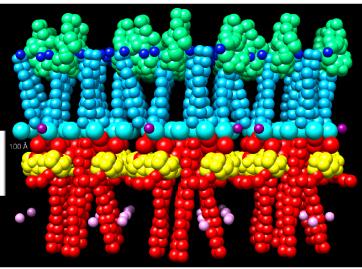Studying mitosis' structure to understand the inside of cancer cells

During mitosis, microtubule-organizing centers assemble the spindle fibers that separate the copying chromosomes of DNA. Researchers are now trying to decipher their molecular architecture. Integrative structure model of the yeast spindle pole body core, showing the proteins: Cnm67 (green), Spc42 (blue), Spc110 (red), Spc29 (purple) and Cmd1 (yellow). Credit: Shruthi Viswanath
Cell division is an intricately choreographed ballet of proteins and molecules that divide the cell. During mitosis, microtubule-organizing centers (MTOCs) assemble the spindle fibers that separate the copying chromosomes of DNA. While scientists are familiar with MTOCs' existence and the role they play in cell division, their actual physical structure remains poorly understood.
Shruthi Viswanath, a postdoctoral scholar at the University of California, San Francisco, with a team of researchers, is trying to decipher the molecular architecture of the MTOC. They will present their work during the 62nd Biophysical Society Annual Meeting, held Feb. 17-21, in San Francisco, California.
MTOCs are specially designed structures within the cell that create, anchor and stabilize the network of microtubules that act like scaffolding within the cell. More than 1,000 proteins are associated with the MTOC in animal cells, but few of these proteins have been assigned a particular function.
Rather than untangle the complexity of the MTOC, Viswanath focused her research on yeast cells. Within these simpler organisms, the spindle pole body (SPB) functions like the MTOC. Unlike in animal cells, the SPB of yeast contains only 18 proteins and Viswanath has initially focused on five core proteins: Spc110, Spc42, Cnm67, Spc29 and Cmd1.
Using multiple techniques such as structural modeling, X-ray scattering, X-ray crystallography and electron microscopy, Viswanath and her team found that the Spc110 protein provides a greater function in the SPB than originally believed. At first, scientists thought these proteins acted as mere spacers holding pieces of the SPB architecture in place, but now it is believed these proteins may provide a binding surface for this architecture. This information can help understand the function of the human cell equivalent of SPBs called centrosomes. Cancer cells in most forms of cancer reveal abnormalities in the size or structure of centrosomes. Future experiments are necessary to identify the position of other key proteins, like Spc29, a critical protein in the SPB core and to eventually identify its specific function.
###
185-Plat “A Bayesian integrative structure model of the yeast centrosome” is authored by Shruthi Viswanath, Massimiliano Bonomi, Seung Joong Kim, Vadim A. Klenchin, Keenan Taylor, King C. Yabut, Neil T. Umbreit, Janet Meehl, Michele H. Jones, Javier Velazquez-Muriel, Mark Winey, Ivan Rayment, Trisha N. Davis, Andrej Sali and Eric D. Muller. It will be presented at 4:30 p.m. PST, Sunday, Feb. 18, 2018 in the South, Level Two, Room 207-208 of the Moscone Center, South. Abstract: https:/
MORE MEETING INFORMATION
ABOUT THE MEETING
Each year, the Biophysical Society Annual Meeting brings together more than 6,000 researchers working in the multidisciplinary fields representing biophysics. With more than 3,600 poster presentations, over 200 exhibits, and more than 20 symposia, the BPS Annual Meeting is the largest meeting of biophysicists in the world. Despite its size, the meeting retains its small-meeting flavor through its subgroup symposia, platform sessions, social activities and committee programs. The 62nd Annual Meeting will be held at the Moscone Center (South) in San Francisco, California.
PRESS REGISTRATION
The Biophysical Society invites professional journalists, freelance science writers and public information officers to attend its Annual Meeting free of charge. For press registration, contact Ellen Weiss at EWeiss@biophysics.org or the Media Line at the American Institute of Physics at media@aip.org or 301-209-3090.
NEWS RELEASES
Embargoed press releases describing in detail some of the breakthroughs to be discussed at the meeting are available on EurekAlert!, Newswise and Alpha Galileo or by contacting the Media Line at the American Institute of Physics at media@aip.org or 301-209-3090.
QUICK LINKS
Main Meeting Page: https:/
Symposia: https:/
Desktop Planner: http://www.
ABOUT THE SOCIETY
The Biophysical Society, founded in 1958, is a professional, scientific Society established to encourage development and dissemination of knowledge in biophysics. The Society promotes growth in this expanding field through its annual meeting, monthly journal, and committee and outreach activities. Its 9,000 members are located throughout the U.S. and the world, where they teach and conduct research in colleges, universities, laboratories, government agencies, and industry. For more information on the Society, or the 2018 Annual Meeting, visit http://www.
Media Contact
All latest news from the category: Life Sciences and Chemistry
Articles and reports from the Life Sciences and chemistry area deal with applied and basic research into modern biology, chemistry and human medicine.
Valuable information can be found on a range of life sciences fields including bacteriology, biochemistry, bionics, bioinformatics, biophysics, biotechnology, genetics, geobotany, human biology, marine biology, microbiology, molecular biology, cellular biology, zoology, bioinorganic chemistry, microchemistry and environmental chemistry.
Newest articles

Security vulnerability in browser interface
… allows computer access via graphics card. Researchers at Graz University of Technology were successful with three different side-channel attacks on graphics cards via the WebGPU browser interface. The attacks…

A closer look at mechanochemistry
Ferdi Schüth and his team at the Max Planck Institut für Kohlenforschung in Mülheim/Germany have been studying the phenomena of mechanochemistry for several years. But what actually happens at the…

Severe Vulnerabilities Discovered in Software to Protect Internet Routing
A research team from the National Research Center for Applied Cybersecurity ATHENE led by Prof. Dr. Haya Schulmann has uncovered 18 vulnerabilities in crucial software components of Resource Public Key…





















